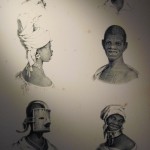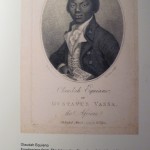I would be lying if I said that I was unaffected by the slavery exhibit at the Dockland Museum. I would also be lying if I said that I expected such a reaction. I realize that the types of heinous treatments and horrific events (as depicted in this museum) are all in the past, but imagining how the enslaved Africans must have felt bothered me immensely. In particular, I saw a painting of six Africans enduring six types of torturous punishments (filed teeth and an iron neck brace, for example), each with a gruesome smile. I was disturbed by their expressions and the way that the artist depicted these people. The image, to me, is utterly haunting.
A group of students and I also watched a short video with images and phrases meant to help the viewer better empathize with how the enslaved Africans must have felt. Describing being away from one’s family, having one’s name changed, and being forced to learn a new language and set of customs were included in this portrayal. I could not help but think of Nanzeen, the main character in Brick Lane. Although her situation was entirely different, many of the ways she felt in the novel were the same. Learning to adapt to an English lifestyle after loving her childhood in Bangladesh seemed to have taken an exceedingly negative toll on Nanzeen’s psyche. I was appalled by that; how much worse, then, would I feel if I fully understood the impact that slavery had on the Africans? I was also a bit put-off by a poster showing a picture of Oleaudah Equiano (or Gustavo Vassa), who wrote The Interesting Narrative of the Life of Oleaudah Equiano. He describes his experience in becoming a freed man and moving to London to make a name for himself as both a hairdresser and musician. In the museum’s representation, he is shown as a hero who worked hard to fight against the slave trade. In reality, though, Equiano recounts instances of him actually working as a part of the slave trade. For a period of time, in fact, he was an overseer on a plantation and reports mistreating other slaves. During these events he had already been freed, and thus could have chosen not to act in such a manner. I feel that, although he may have done good things for the African enslaved community, he also stooped to the level of those who formerly oppressed him. I do not think that this should have been overlooked.
Finally, I was moved by a quote from The Negro’s Complaint, written by William Cowper, stating: “Men from England bought and sold me,/Paid my price in palry gold:/But, though theirs they have enroll’d me/Minds are never to be sold.” I can’t pinpoint exactly why I liked the quote, but I did want to share it regardless.



1 response so far ↓
abarron76 // Aug 24th 2009 at 16:46
There is a very apparent similarity between the American and British enslaving of Africans. Both eras were cruel and unjust and are a true blemish on both of our country’s histories and consciousnesses. There was one major disconnection, however. Following abolition, there was a markedly lower level of anti-black racism in England in comparison to America during The Reconstruction. The Docklands had an interesting section on black gentlemen who seemed to mesh in with white aristocrats. There was a painting of a group of upper class men with an African in the center of the group dressed the same as the white men surrounding him. I am interested in learning more about the similarities and differences in post-slavery racism in the US and the UK.
You must log in to post a comment.